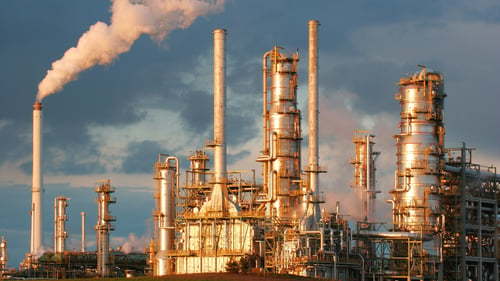Why do Energy Prices Change?
.jpg?width=768&name=Article%20Thumbnails%20-%201920x1080%20new%20website%20(9).jpg)
Energy prices are a hot topic. From plummeting fuel prices at the pump during the pandemic, to the rising gas prices from the conflict in Ukraine, energy prices are more unpredictable than ever. One thing is clear: energy prices are volatile and can change significantly from one day to the next. In terms of energy usage, gas prices are measured per therm, and electricity prices are measured per kilowatt-hour. But what influences these prices?
Breaking down the factors that lead to a shifting energy prices can help customers understand their energy bill and where they might be able to cut costs. But before we can get into that, we first need to get to grips with what energy prices are and how they are influenced.
Jump to:
Unlock New Revenue Streams with Demand Response
Check out our essential guide to energy flexibility.
Understanding Energy Prices
Energy prices are not just a fixed singular cost for the gas and electricity customers use. The figure on your bill is in fact a combination of a number of other costs.
These include:
- network costs
- operating and maintenance costs
- wholesale costs
- taxes
The same is true for fuel prices. The sticker price at the pump is the total sum of several costs in the value chain, including:
- cost of crude oil extraction
- refining
- shipping and distribution
- marketing
- wholesale and retail margins
- taxes, such as VAT
Why do Energy Prices go up?
There are a host of different factors that affect energy prices and cause them to drop or - more commonly - spike. The main three influences on energy prices are the wholesale price, energy supply, and the network operation i.e. transmission and distribution.
Wholesale Costs

Energy suppliers buy energy from gas producers and electricity generators on the wholesale market. This is the wholesale cost, which covers the price paid for the energy, per therm, that supplies homes and businesses. They account for around a third of energy bills.
The wholesale price of energy can affect energy prices significantly and can increase or decrease very suddenly. The wholesale price depends on global geopolitical events that increase or decrease the supply of oil, gas or coal and, in some cases, renewable fuel and energy exports.
Wholesale prices are also influenced by demand. For example, wholesale prices will be lower when there is more fuel and less demand - like during the pandemic when economic activity and transport were limited. An increase in demand leads to higher wholesale prices.
Wholesale price changes don’t always affect all energy customers in the same way. It can depend on a customer’s supplier and their individual energy tariff, and whether it is fixed or not. Suppliers buy energy in advance for their tariffs, sometimes two or three years in advance, which affects the price a customer will pay for the energy they use.
Network and Supplier Costs

Another cost that contributes to overall energy bills is the maintenance of the network. This is essentially the cost of infrastructure needed to transmit and distribute energy across the network.
This infrastructure - mostly gas pipes and electricity cables - carry energy nationally and internationally to where it is used by energy customers in their homes and businesses.
Network operators charge energy suppliers for their use of the energy networks. In the UK, this charge is overseen by the energy regulator Ofgem, which ensures the money is used to maintain, upgrade and operate the networks.
Energy suppliers will take network and operation costs into consideration when pricing their energy, to cover the expense and generate profit. Supplier’s operation costs also cover customer services, billing and the general costs of running an energy business.
Network costs are variable and shift in line with how energy is used and where costs need to be allocated to different parts of the network. Network costs also include the price of ‘balancing,’ which refers to the real-time balancing of supply and demand to keep the network stable at 50Hz. Balancing costs are also not fixed, and can go up or down over time.
Supply and Demand

If we look at energy as a product, it’s easy to understand that the price of energy is affected by the flow of supply and demand. Like all markets, if demand is high and supply is low, the cost of energy will go up, and vice versa.
The factors that limit the supply of energy are global and often political in nature. For example, interruptions to supply chains can arise as a result of geopolitical tensions between countries that are energy exporters and importers, like the recent limited supply of gas being exported to the EU from Russia.
Similarly, when demand for energy surges, it also causes the price to rise. Extreme weather can be a trigger for significantly increased energy demand. During heat waves like those experienced throughout Europe and North America in 2022, excess energy is needed to cool buildings with fans, and air conditioning. During peak times of the day, this can cause the price of energy to be more expensive, as there is more pressure on the grid.
How can I Reduce my Energy Cost?

During times of energy cost inflation, high energy bills may seem inescapable. However, there are measures that can help bring down the cost of energy, especially for businesses that require large amounts of power to run their daily operations.
One solution that can be implemented on a large scale is demand response. Demand response is a kind of energy network flexibility. It is a change in electricity consumption by consumers that can help keep the supply and demand in balance. It is particularly effective when applied at a large scale, by commercial and industrial businesses, or residential blocks.
Demand response is one lever that can be pulled to alleviate pressure on the grid from customer demand. Demand response programmes identify energy consumption trends and needs, and shift customers’ energy use accordingly to avoid using power during peak times, when costs are high. Although this is simple in theory, it is considered a vital part of ensuring energy security and also results in lower costs when the energy bill arrives.
In some countries, there are financial incentives such as credits on energy bills for those who choose to participate in demand response programmes.
There is no silver bullet to avoid global trends that cause high energy prices. But programmes like demand response and flexibility are an important part of understanding energy consumption and how it relates to costs so that there is less cause for alarm when the end of the month bill arrives.
____________________________________________________________________
Sympower is dedicated to creating a fully renewable energy system. We are the energy experts with years of experience in demand response and flexibility optimisation. Our goal is to turn the potential of your energy assets into extra revenue for you. We provide the technical expertise, all while you stay in control.
Other articles you might find interesting
-
 Demand-side flexibility11 April 2023
Demand-side flexibility11 April 2023Five Myths About Demand Response, Debunked!
Read more -
.jpg?length=500&name=Article%20Thumbnails%20-%201920x1080%20new%20website%20(35).jpg) Demand-side flexibility11 April 2023
Demand-side flexibility11 April 2023smartEn Executive Director Michael Villa on the future of energy flexibility in Europe
Read more -
 Energy management11 April 2023
Energy management11 April 2023Going From Passive to Active as an Energy Consumer - Q&A with Gianluca Rimini
Read more -
.jpg?length=500&name=Article%20Thumbnails%20-%201920x1080%20new%20website%20(6).jpg) Demand-side flexibility11 April 2023
Demand-side flexibility11 April 2023Five Times Demand Response Saved the Grid
Read more -
.jpg?length=500&name=Article%20Thumbnails%20-%201920x1080%20new%20website%20(12).jpg) electrification11 April 2023
electrification11 April 2023What are Energy Markets?
Read more -
.jpg?length=500&name=Article%20Thumbnails%20-%201920x1080%20new%20website%20(13).jpg) Energy markets11 April 2023
Energy markets11 April 2023Load Shedding Explained
Read more -
.jpg?length=500&name=Article%20Thumbnails%20-%201920x1080%20new%20website%20(15).jpg) Energy markets11 April 2023
Energy markets11 April 2023How to Grow with the Energy Transition
Read more -
.jpg?length=500&name=Article%20Thumbnails%20-%201920x1080%20new%20website%20(24).jpg) Energy markets11 April 2023
Energy markets11 April 2023Securing Europe’s energy supply: the role of platforms for ancillary services
Read more